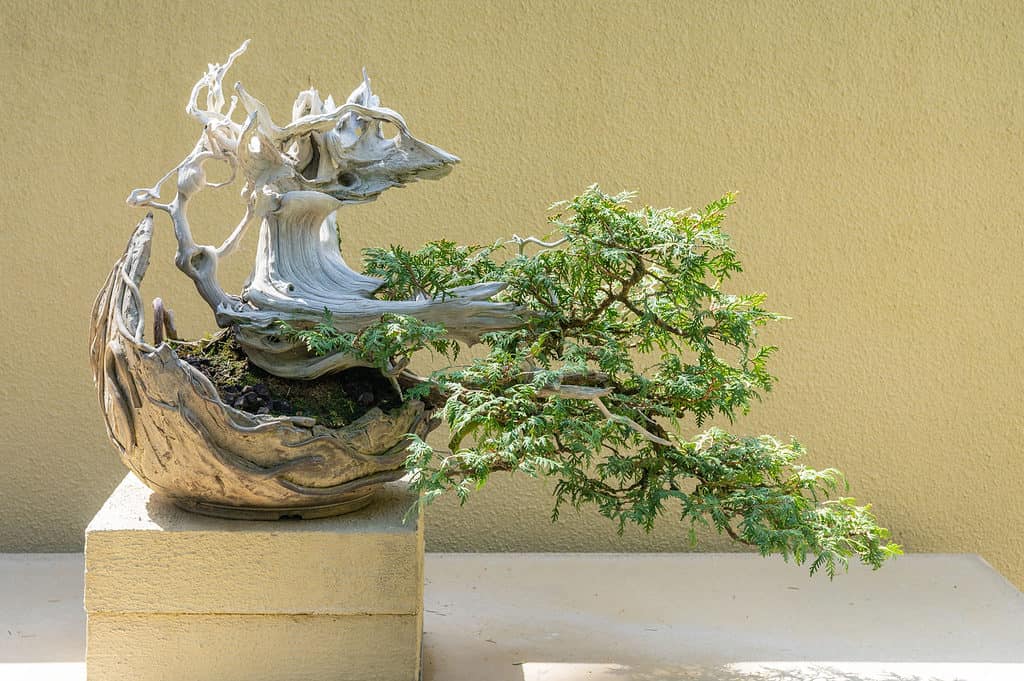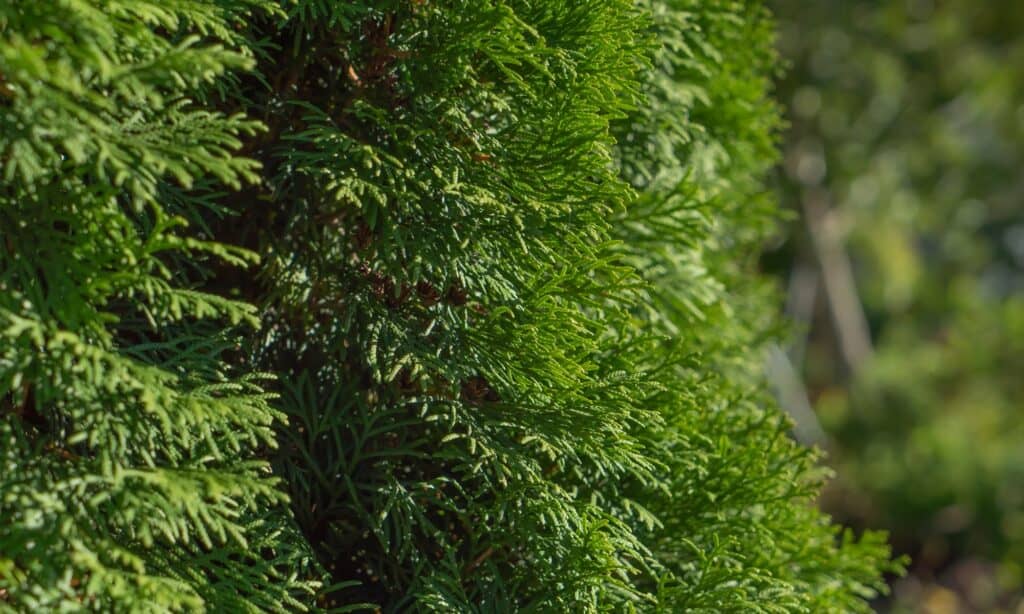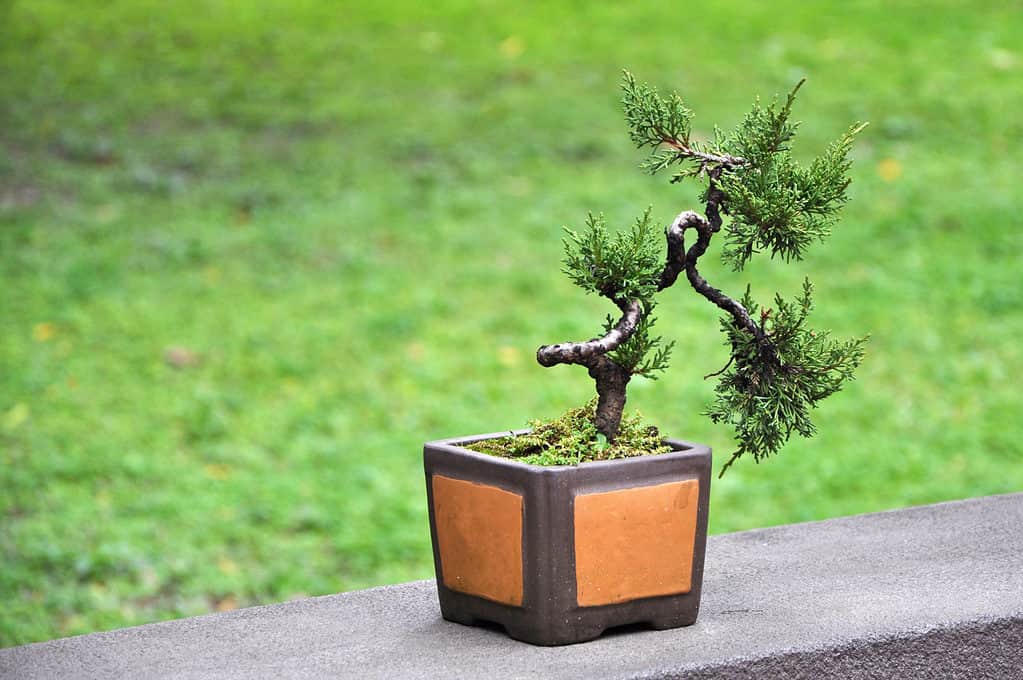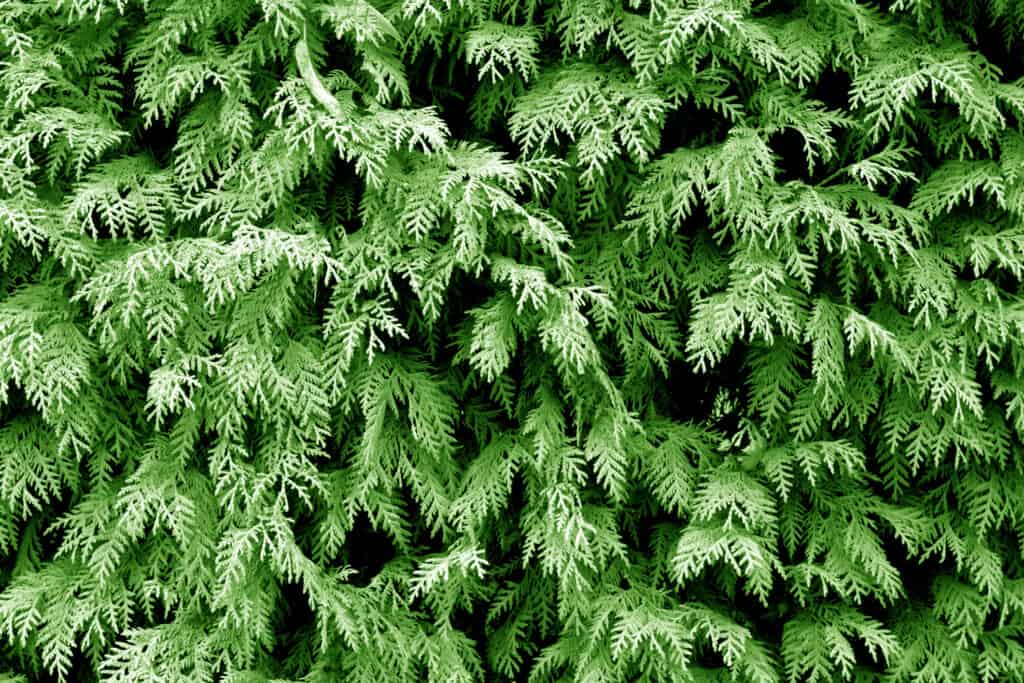Thuja trees are among the oldest in the world. Research tells us that they were widespread tens of millions of years ago in North America and Asia. Many types of thuja trees are sacred and important trees to the indigenous peoples of North America and Asia. They would use thuja trees in almost every aspect of their everyday lives. This has led to thuja trees also being known as arborvitaes, which is a Latin term meaning “tree of life”.
Thuja trees can also be grown as Bonsai trees. They can be relatively easy to care for, although pruning can prove difficult. But the majesty of these beautiful trees makes the challenge more than worth it!
Here is everything you need to know about caring for a thuja bonsai tree!

Thuja trees are among the oldest in the world and make beautiful Bonsai trees.
©Mariusz S. Jurgielewicz/Shutterstock.com
| Thuja Bonsai Tree Information | |
|---|---|
| Botanical Name | Thuja |
| Common Types | Western red cedar, Japanese thuja, Northern white cedar, Eastern arborvitae, Golden globe, Green Giant arborvitae, Holmstrup arborvitae |
| Sunlight | Full sunlight to partial shade |
| Soil | Acidic or alkaline, depending on the type of tree |
| Water | Well-draining; keep the rootball moist and be careful not to let it dry out |
| For Beginners? | Thuja Bonsai trees are better suited to intermediate and even advanced skill sets. Taking care of one of these trees isn’t too difficult all around but it is the pruning and shaping that proves difficult. |
| Indoors or Outdoors? | Indoors, for the most part, year-round. Thuja Bonsai trees need shade in the summer and protection from frost in the winter. |
| Pairs Well With… | Rocks and moss, other natural ornamentation |
Common Types of Thuja Bonsai Trees
Thuja trees are versatile, ranging in size, shape, and appearance. Some are massive, standing over 200 feet tall. Others resemble shrubs instead of traditional trees.
There are two species of thuja trees that are native to North America, and three that are native to Asia. Of these five species, there are multiple cultivars. Here are some of the most common types of thuja Bonsai trees!
Western Red Cedar

Despite being among the tallest trees in the world, Western red cedar trees can be grown as Bonsai trees!
©Marinodenisenko/Shutterstock.com
Despite being called a cedar tree, the Western red cedar is not actually a cedar tree. It is indeed part of the thuja genus. This type of tree can be found throughout the Pacific Northwest. These trees were, and still are, very important to the indigenous peoples of the area. They would use these trees to make all kinds of items that they used in their everyday lives. Because of this, the western red cedar has earned the nickname of “tree of life”.
The Western red cedar is among the tallest trees in the world. They can live for hundreds of years. These trees do not tolerate drought very well. They thrive best when planted in moist, well-draining soil that is on the acidic side.
Japanese Thuja
The Japanese thuja tree has been around for centuries. During the Edo period specifically, these magnificent trees were regarded as sacred, among four other types. These trees were referred to as the five sacred trees of the Kiso Forest. Their wood was used only to construct temples and homes. Nowadays, the Japanese thuja is used for commercial lumber. It is still a very important tree in that regard.
These trees do not tolerate drought very well. They thrive best when planted in moist, well-draining loam that is on the alkaline side. If a Japanese thuja tree is growing in a place with a cool climate, it can grow beneath full sun. If it is growing in a place with a hot climate, it does need partial shade. While it can tolerate full shade, it does not grow very well beneath it.
Northern White Cedar

One of the most popular varieties of thuja trees used in Bonsai tree art, these trees have gray bark.
©Elliotte Rusty Harold/Shutterstock.com
Perhaps the most popular variety of thuja trees for Bonsai tree art is the Northern white cedar. They are known for their gray-colored bark. These slow-growing trees grow upright, eventually reaching heights of 70 feet in the wild.
Because the roots of Northern white cedar trees are shallow, this makes them ideal for Nebari. Nebari is known as surface roots, and involves shaping the shallow roots of a Bonsai tree.
Eastern Arborvitae
Eastern arborvitae trees are technically considered shrubs. They are one of the most popular choices for privacy hedges in the United States, but they can also be grown as Bonsai trees! Eastern arborvitae trees can thrive in most sun conditions, though they do prefer at least some sun to grow their best. As for soil, eastern arborvitae trees need moist, well-draining, alkaline soil.
Golden Globe
These evergreen shrubs look the way their name suggests: a golden globe! They assume a natural spherical shape when left to grow, and the yellow-gold color of their leaves stays year-round! Growing a Golden Globe arborvitae as a Bonsai tree can be a bit challenging because of this unique shape, but it would be worth it!
These shrubs grow at a slow to moderate rate, at less than 2 feet per year. To thrive, Golden Globe arborvitae trees need some sun. At least 4 hours of direct sunlight a day is recommended. They grow best in loamy, acidic soil that drains well.
Green Giant Arborvitae

Quick-growing Green Giant trees need more pruning and attention to keep them at a good height for Bonsai art!
©iStock.com/IgorTsarev
The Green Giant Arborvitae is known for its vivid green foliage. This foliage changes color in the winter—it either grows darker or turns a more brownish, bronze shade. These trees grow at a quick rate, so they need a decent amount of pruning and attention to keep them at a good Bonsai tree height.
To help your Green Giant arborvitae Bonsai tree grow its best, make sure to expose it to at least some sun every day. Four hours of direct sunlight a day is recommended. As a whole, these trees can tolerate many different soil conditions. They thrive best in soil that drains well, though.
Green Giant arborvitae trees are considered to be public domain trees. This means that anyone can propagate them from cuttings.
Holmstrup Arborvitae
The branches of Holmstrup arborvitae trees are dense and grow close together. The rich, dark green color of the foliage stays throughout the year, even during the cold months. These shrubs love moist, loamy, well-draining soil and require at least four hours of direct sunlight every day in order to grow their best. Holmstrup arborvitae shrubs grow at a slow rate, which means they do not require as much pruning as other thuja trees on this list!
Caring for Your Thuja Bonsai Tree

To thrive, thuja Bonsai trees need a lot of moisture!
©Piu_Piu/Shutterstock.com
Thuja trees can be low maintenance in the right conditions. To grow their best, they need a bit of extra attention from time to time. Here is everything you need to know about caring for a thuja Bonsai tree!
Sunlight
To grow their best, thuja Bonsai trees need at least four hours of direct sunlight a day. When it gets too hot, however, it is best to limit how much direct sunlight your thuja Bonsai tree gets. Make sure to provide some shade, especially during the hot summer months, because the leaves of these trees can get scorched easily.
Soil Type
For the most part, thuja Bonsai trees can tolerate most soil conditions. Some of them thrive best in acidic soils, others in alkaline soils, but across the board, thuja Bonsai trees do need moist, well-draining soil. There are specially-made soils for Bonsai trees, and your thuja Bonsai tree would benefit greatly from these soils as they are designed to stay moist and be well-draining! A regular Bonsai tree soil mix would suit a thuja Bonsai tree well!
Water
Most Bonsai trees need their rootball to stay moist as often as possible. Thuja Bonsai trees are the same. When grown naturally, these trees and shrubs thrive best in moist, damp environments and as Bonsai trees, they still need this moisture!
Placement
Placing your Bonsai tree properly can really help it grow well!
Thuja Bonsai trees can grow under full sun as well as in partial shade. Outside of the hot summer months, keeping a thuja Bonsai tree outdoors where it can be under the sun is a good idea! The leaves of these trees and shrubs can scorch easily, though, and since they love moisture, it is best to bring them indoors or place them under shade when the weather grows too hot.
Even though most thuja trees are evergreen, conifer trees and can withstand frost and the cold better than most, they become a bit weak when planted in Bonsai tree containers. This means that in the winter months, thuja Bonsai trees need extra protection against frost and the cold.
Pruning Your Thuja Bonsai Tree

Many types of Bonsai trees do not take well to heavy pruning, but thuja trees can.
©Olena Antonenko/Shutterstock.com
Pruning a Bonsai tree can be very challenging, but for the most part, the thuja tree makes it easy. Many types of Bonsai trees do not take well to heavy pruning, but thuja trees can. Even after pruning or trimming branches back into the old wood, a thuja Bonsai tree will still bloom. Heavy pruning like this should be done in late autumn.
Ideal Thuja Bonsai Tree Styles
There are many Bonsai tree styles into which a thuja tree can be pruned and grown, depending on the type of thuja you are working with. Some of the most popular include the Chokkan style, Yose-ue, and Sokan. The Chokkan style is also known as the upright style. Thuja trees suit this style because of their thick trunks. But some thuja trees grow smaller or thinner, which makes them perfect for the Yose-ue style. This is also known as the forest style. The Sokan style of Bonsai trees involves splitting your Bonsai tree into two trunks. Thuja trees are also suited to this style!
Propagating Your Thuja Bonsai Tree

Green Giant arborvitaes are considered public domain trees, which means anyone can propagate them from cuttings.
©iStock.com/pavelalexeev
Thuja trees can be easily propagated from both cuttings and seeds. The Green Giant thuja tree, for instance, is considered a public domain tree which means that anyone can propagate them from cuttings.
Common Problems with Thuja Bonsai Trees
Unfortunately, there are many different pests that can attack your thuja Bonsai tree. Some of these pests include cypress tip miners, arborvitae leaf miners, Japanese beetles, and bagworms. They can also fall victim to root rot since they must be kept so moist. For the issue of pests and insects, specific pesticides can be used.
Thank you for reading! Have some feedback for us? Contact the AZ Animals editorial team.








